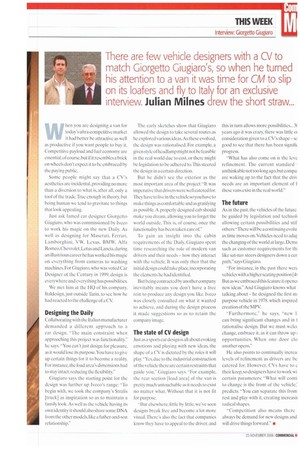There are few vehicle designers with a CV to match
Page 25

If you've noticed an error in this article please click here to report it so we can fix it.
Giorgetto Giugiarois, so when he turned his attention to a van it was time for CM to slip on its loafers and fly to Italy for an exclusive
interview. Julian Milnes drew the short straw...
you are designing a van for today's ultra-competitive market it had better be attractive as well as productive if you want people to buy it. Competitive payload and fuel economy are essentia l,of course.but if it resembles a brick on wheels don't expect it to be embraced by the paying public.
Some people might say that a CV's aesthetics are incidental, providing no more than a diversion to what is, after all, only a tool of the trade, True enough in theory, but being human we tend to gravitate to things that look appealing.
Just ask famed car designer Giorgetto Giugiaro. who was commissioned by Iveco to work his magic on the new Daily. As well as designing for Maserati, Ferrari. Lamborghini. VW. Lexus, BMW, Alfa Romeo, Chevrolet. Lotus and Lancia.during an illustrious career he has worked his magic on everything front cameras to washing machines. For Giugiaro, who was voted Car Designer of the Century in 1999, design is everywhere and everything has possibilities.
We met him at the HO of his company, haldesign, just outside Turin, to see how he had reacted to the challenge of a CV.
Designing the Daily
Collaborating with the Italian manufacturer demanded a different approach to a car design. "The main constraint when approaching this project was functionality," he says. You can't just design for pleasure. as it would lose its purpose. You have to give up certain things for it to become a reality. For instance, the load area's dimensions had to stay intact, reducing the flexibiliq,."
Giugiaro says the starting point for the design was further up Iveco's range: "To begin with, we took the company's Stralis [truck] as inspiration so as to maintain a family look.As well as the vehicle having its own identity it should also share some DNA from the other models, like a father-and-son relationship." The early sketches show that Giugiaro allowed the design to take several routes as he explored various ideas. As these evolved, the design was rationalised. For example, a given style of headlamp migh t not be feasible in the real world due to cost, or there might be legislation to be adhered to.This steered the design in a certain direction.
But he didn't see the exterior as the most important area of the project: "It was imperative that drivers were well catered for. They have to live in the vehicle so you have to make things as comfortable and as gratifying as possible. A properly designed cab should make you dream, allowing you to forget the world outside. This is, of course, once the functionality has been taken care of."
To gain an insight into the cabin requirements of the Daily, Giugiaro spent time researching the role of modern van drivers and their needs how they interact with the vehicle. It was only then that the initial design could take place, incorporating the elements he had identified.
But being contracted by another company inevitably means vou don't have a free rein to produce any design you like. Iveco was closely consulted on what it wanted to achieve, and during the design process it made suggestions so as to retain the company image.
The state of CV design
Just as a sports car design is all about evoking emotions and playing with new ideas, the shape of a CV is dictated by the roles it will play."Yes.due to the industrial construction of the vehicle there are certain restraints that guide you,Giugiaro says. "For example, the rear section 'load area I of the van is pretty much untouchable as it needs to exist no matter what. Without that it is not fit for purpose.
"But elsewhere, little by little, we've seen designs break free and become a lot more visual. There's also the fact that companies know they have to appeal to the driver, and this in turn allows more possibilities_ 3( years ago it was crazy, there was little oi consideration given to a CV's shape — sc good to see that there has been signific progress.
"What has also come on is the leve refinement. The current standard • unthinkable not too long ago, but compa are waking up to the fact that the driv needs are an important element of these vans exist in the real world."
The future
As in the past. the vehicles of the future be guided by legislation and technoll allowing certain possibilities and stif others:"There will he a continuing evolu as time moves on. Vehicles need to adar the changing of the world at large. Dema such as customer requirements for thi like sat-nay steers designers down a cer path ," says Giugiaro.
"For instance, in the past there wert vehicicswiih a higher seating position [4) But as we embraced this feature it openo new ideas." And Giugiaro knows what talking about — he designed the first purpose vehicle in 1978. which inspired creation of the MPV.
"Furthermore," he says. "new l; can bring significant changes and in t rationalise design. But we must wele( change, embrace it. as it can throw up opportunities. When one door clo another opens."
He also points to continually increal levels of refinement as drivers are he catered for. However. ('Vs have to their keep, so designers have to work wi certain parameters: "What will conti to change is the front of the vehicle,' predicts. "You can separate this from rest and play with it, creating increash radical shapes.
"Competition also means there always be demand for new designs and wilt drive things forward." •




































































































































































































































